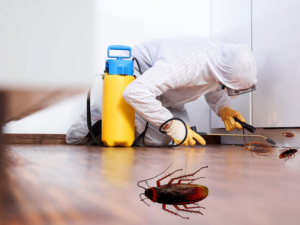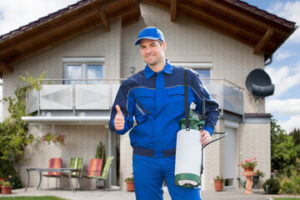Pests are unwanted organisms that damage plants or animals. Various methods, including prevention, suppression, and eradication, can be used to control pests.
The goal of prevention is to keep pests from entering an area. Barriers, traps, screens, and nets can help, and chemicals can keep pest numbers below acceptable levels. Visit the Website to learn more.

Pests are more than just a nuisance; they can cause major property damage and pose health threats. They also can destroy your home’s structure and increase its vulnerability to storm damage. If you are dealing with an infestation, it is vital to act quickly to prevent further damage and costly repairs. A pest control company can help you address your problem by using physical, biological, and chemical methods.
Physical pest control involves creating barriers to prevent pests from entering a home or building. It includes sealing cracks, repairing gaps and caulking, and eliminating pests’ nesting areas. It also includes reducing clutter in and around a building, which can provide hiding places for pests. Lastly, it can include installing traps and bait stations to capture and kill pests.
Biological pest control uses a natural predator or parasite to reduce a pest population. This method is typically organic and does not require chemicals, which makes it more environmentally friendly. However, this approach usually takes more time than other methods.
Chemical pest control uses harsher chemicals to destroy a pest infestation. It can involve a variety of methods, including spraying and fogging. It can also involve baits and granules. Chemical pest controls are often the best option when addressing large infestations of pests, especially when they are resistant to other types of control methods.
Insects and rodents are attracted to food, water and shelter. Eliminating these attractants can significantly reduce the risk of pest infestation. Regularly cleaning crumbs and spills, storing food in airtight containers, and disposing of garbage promptly can eliminate potential sources of pests. It is also a good idea to keep outdoor toys, furniture and debris away from the house and to wipe down surfaces before bringing them indoors.
Regular inspections can detect early signs of a pest problem. Pests can quickly breed and spread, so if you notice droppings or gnaw marks, it is important to take prompt action. Keeping up with your inspections can reduce the cost and severity of pest problems, saving you money and preventing health risks for yourself, family members and pets.
Suppression
Pest control aims to reduce pest numbers and damage to an acceptable level. This can be achieved through prevention, suppression, eradication, or some combination of these methods. Prevention is the best approach since it causes the least harm to people and other organisms. In addition, preventive strategies can be cheaper and more environmentally friendly than pesticides. Integrated Pest Management, or IPM, is an ecosystem-based strategy that uses biological, physical, chemical and cultural controls to reduce the use of chemicals in agriculture, garden and landscape settings and natural areas.
Natural enemies — predators, parasites and pathogens — are effective in controlling many pest species. These natural enemies may be introduced directly into the environment in small, repeated batches or in large, single releases. In addition, certain plant growth regulators — such as hormones — can also be used to control some insect pests. These plant chemicals (called pheromones) mimic the behavior of a target pest, encouraging other insects of that species to attack it.
Weather conditions such as temperature, day length, and humidity affect pest population sizes and activity. In addition, topography and geographic features restrict the spread of some pests. Many pests also depend on water for survival. If the water supply is restricted, the pests die or become inactive.
Soil conditions can influence the development of pest populations, as can plant genetics and cultivars that have been selected for disease resistance. Insect pests are often infected with bacteria, fungi or viruses that slow, stop or even kill them. Insect pests may also be infected with nematodes that eat them from within.
Cultural practices such as crop rotation, mulching, and proper spacing can limit the spread of some pests. Similarly, irrigation can be controlled to minimize the spread of pathogens by using less water and applying it at lower rates on cloudy days or in the evening when the leaves are dry.
Chemicals can be used to control pests, but they should be applied only when necessary and with caution. Most chemical products can affect the health of beneficial organisms and cause other environmental problems. Some also have a long residual, which can lead to the accumulation of toxic residues in soil and water.
Eradication
Unlike control, eradication means the elimination of a pest population in a given area. Often this involves multiple steps and is accomplished by reducing the reproductive rate to zero, destroying all vectors and intermediary hosts, and ensuring that no one can become infected. Eradication is the highest level of pest control and is considered to be the most desirable outcome, although it may not be feasible for some diseases due to the difficulty of eliminating microbes from natural environments and the persistence of some environmental conditions that favor disease transmission (Cochi and others 1998; de Quadros 2001).
A pest control program should strive to eliminate pests while minimizing adverse effects on humans, other animals, plants, and the environment. This goal requires an understanding of the biological systems that govern the ecology of pests and their interaction with their human host. It also requires an appreciation of the complexity and variability of a variety of factors that affect the transmission of disease, such as the relative reproductive rates of vectors, their prey, and humans; the density of intermediate hosts; and the availability of other suitable habitats (Dowdle and Hopkins 1998).
In order to eradicate a pest infestation, the first step is to destroy all adult insects, rodents, and other vertebrates. This step can be accomplished using traps and baits, which are usually targeted at the specific pests rather than the entire species, or by spraying or dipping. The next step is to close off places where the pests can enter and hide, such as by caulking cracks and crevices or by filling them with steel wool. This step should be followed by a thorough cleaning, especially under and around appliances, to remove any food sources or hiding places for the pests.
Finally, the pest control process must be monitored to ensure that it is working and to catch any recurrences. This is a difficult task, as it relies on accurate surveillance and the ability to detect infection of a susceptible individual. In addition, there are often serious financial constraints that limit eradication efforts.
Monitoring
Pests cause damage to crops, livestock, and structures. They also carry diseases that affect humans and other animals, threaten public health, and cause loss of property. Often, pests are invasive species that disrupt ecosystems. Pest control is a complex business, requiring constant monitoring of the environment and the application of physical and chemical methods to keep pest populations in check.
The first step in any pest control program is identification of the pest. This includes determining what the pest looks like, where it lives, and what conditions are favorable for its development and spread. This information is used to develop a plan for managing the pest, such as through prevention or suppression.
Once a pest has been identified, scouting and monitoring must be done to determine its population levels. This will help decide whether action needs to be taken or if the current level of pests is acceptable. For example, seeing a few cockroaches in your kitchen every now and then may not warrant action, but if you see them regularly, it is likely time to call the pest control company.
Thresholds are important because pest control is not just about removing a few pests, but about balancing the needs of all organisms sharing a treatment site. If the balance is disturbed, other species in the area may suffer. For example, overhunting of passenger pigeons resulted in their extinction because the birds competed with agricultural crops for food and water resources.
Keeping pests at bay is essential for both commercial and residential properties. The pests that most often need eradication by pest control services include rodents, insects, and weeds. These pests can contaminate food, ruin buildings, and trigger allergies and asthma in humans and other animals. They can also leave droppings that contaminate the indoor air, causing respiratory problems for people in the building. Rodents and insects can also spread disease, while the chemicals used to get rid of them can pose risks to human health and the environment. Safe pest control is a team effort, and everyone has a role to play, from building owners to tenants and maintenance workers.
